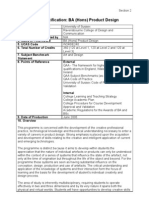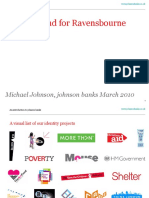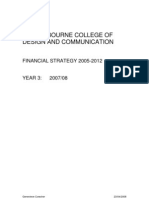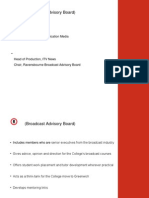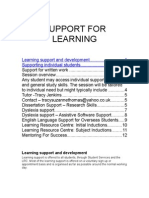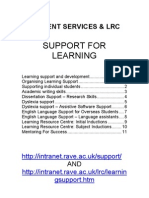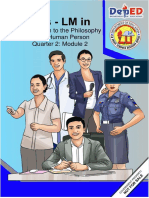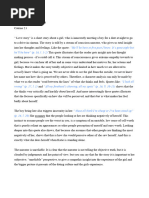Programme Specification: BA (Hons) Graphic Design: Faculty of Communication Media Definitive Document: 21 July 2006
Uploaded by
lisaconnollyProgramme Specification: BA (Hons) Graphic Design: Faculty of Communication Media Definitive Document: 21 July 2006
Uploaded by
lisaconnollySection 2
Programme Specification: BA (Hons) Graphic Design
1. Awarding Institution University of Sussex
2. Teaching Institution Ravensbourne College of Design and
Communication
3. Programme Accredited by N/A
4. Name of Final Award BA (Hons) Graphic Design
5. UCAS Code W210/E210
6. Total Number of Credits 360 (120 at level 1, 120 at Level 2 & 120 at Level
3)
7. Subject Benchmark Art and Design
Statement Communication, media, film and cultural studies
8. Points of Reference External
QAA - The framework for higher education
qualifications in England, Wales and Northern
Ireland
QAA Subject Benchmarks (as above)
QAA Code of Practice
University of Sussex Code of Practice for
Validation
Industry Advisory Committee
Student Consultation
Internal
College Learning and Teaching Strategy
College Academic Plan
College Procedure for Course Development
Approval and Validation
Academic Regulations for the Awards of BA and
BSc
9. Date of Production October 2005
10. Overview
This programme is concerned with the development of the creative professional
practice, technological knowledge and theoretical understanding necessary to enter a
variety of careers in the area of graphic design.
This programme of study offers an excellent understanding of the broader areas of
graphic design and a good grounding in the principles and methods of information
design.
It aims to develop articulate and reflective design practitioners who are well equipped
to influence the future direction of the subject and profession. Emphasis is placed on
developing graduates who will have an understanding and sympathy of the needs of
the target user and society as a whole and who can define, plan, and shape the
contents of a message and the environments in which it is presented with the intention
of achieving particular objectives in relation to the needs of users.
Through progressively complex delivered units students learn to think innovatively and
systematically as well as being familiar with the technical requirements of the
Faculty of Communication Media 1 Definitive Document: 21 July 2006
Section 2
communications media, specifically the visual ones. Student learn to problem solve;
communicate the message, ideas and arguments; design for the user experience; and
to identify the best use of technology for the circumstance.
Whilst vocational, all levels the programme is underpinned by a central and subject
specific academic profile. It combines both visual and cultural theory allowing all
students to establish a context for their work through historical and critical debate,
relating and integrating theory and practice.
Level 1 begins the process of developing the student’s full creative potential. Students
will develop the fundamental graphic design knowledge and skills required in order to
work as a design practitioner on storytelling concepts and narrative, layout,
typography, information design and wayfinding. Core values explored in this level
include: idea origination; intellectual curiosity; and technology & craft skills. All work is
underpinned with core and subject specific contextual studies linking theory and
practice as well as the development of independent learning strategies and skills.
Level 2 builds on professional skills developed in the first level within the areas of
information, branding and wayfinding design projects as well as encompassing spatial
design. There is a distinct emphasis on ‘live’ client and designer scenario projects.
Throughout the year students will be developing their design research, analytical and
communication skills, and exploring how society, culture and economics impact upon
their work. They will continue to reflect upon their own learning, performance and
achievement, through personal and professional development. Towards the end of
Level 2 students will consider and begin dissertation preparation for the Level 3
Dissertation unit. There is an opportunity in the second term of the course for students
to undertake a work placement within a professional practice/studio. The level also
encompasses opportunities for cross course/faculty collaborations.
Level 3 is an opportunity for students to develop, integrate and consolidate all their
acquired knowledge and skills and apply them in an independent fashion on a series
of independent projects in order to prepare for their future careers. Work in this level
may include multidisciplinary work, competition briefs and/or self negotiated project
briefs. Students will also independently research and prepare a dissertation.
Faculty of Communication Media 2 Definitive Document: 21 July 2006
Section 2
11. Educational Aims of the Programme
The course aims to provide graduates with the knowledge and skills appropriate to a
range of career outcomes in graphic design. Students are encouraged to develop
their individual creative ability and support this with the development of a high level of
technical skills. In particular, the programme aims to enable students to develop:
1. a range of creative, technical and professional skills relevant to employment in
graphic design and related areas;
2. an understanding of the key critical, social, cultural, historical and business
concepts, issues and debates relevant to the area of graphic design;
3. a comprehensive knowledge of contemporary professional practice and the
creative process in the professional field in which they will specialise and an
awareness of current areas of development and innovation;
4. the ability to make creative use of and experiment with new and existing
technologies;
5. a clear vision of where their creative strengths lie and how this can be utilised
in design for graphic design and potential career opportunities;
6. skills in research, analysis, problem solving and critical reflection and the
visual, written and verbal communication skills required of a graduate entrant to
the graphic design and related industries;
7. initiative and personal responsibility, experience of collaborative working
methods and the ability to be responsive and adaptable to changing needs,
and the transferable skills and competencies which enable life-long learning.
Faculty of Communication Media 3 Definitive Document: 21 July 2006
Section 2
12. Intended Learning Outcomes - This programme provides opportunities for
students to develop and demonstrate knowledge and understanding, skills, qualities
and other attributes in the following areas:
KNOWLEDGE AND UNDERSTANDING
A - Knowledge and Understanding of: Teaching and Learning Methods
1. the design process in general and Learning and teaching in relation to these
specifically in Graphic Design learning outcomes tends to be primarily
2. narrative processes, generic forms and project based (see Practical and
modes of representation Professional Skills below). This is
3. visual languages used to articulate supported by varied learning and teaching
concepts and ideas in narrative, visual and methods which may include as appropriate:
time dimensions project briefings, studio based lectures,
4. the depth, breadth and creative potential (staff and student led) group seminars,
of the technologies upon which the technical or practical workshops,
discipline of Graphic Design is based demonstrations, critiques, individual or
5. the nature of technological change and group tutorials and self directed study by
the continuous development of knowledge the student.
6. the production process(es)and the roles
involved and their relationships in graphic Learning is facilitated by well qualified,
design, information design and wayfinding permanent teaching staff and by sessional
7. key professional practices and business staff and visiting speakers who are
processes necessary to underpin graduate practising professionals and bring an
employment in the creative industries important industry perspective to the
8. a critical understanding of design, course. Traditional modes of delivery may
communication and media practice and be supported where appropriate by e-
theory in the context of history, society, learning and/or resource based learning.
contemporary global culture, business and
an appreciation of the significance of the Contextual and theoretical learning are
work of other practitioners delivered both as an integral part of the
practice based units and separately in a
progressive series of mandatory cross
College units. This prevents a
theory/practice dichotomy while ensuring
that this aspect of learning is sufficiently
weighted in the curriculum.
Assessment Methods
Knowledge and understanding is primarily
assessed through essays, reports and
individual and group presentations, and
through its application in practical projects
in a manner appropriate to each unit of
delivery. Some units additionally require
the submission of rationales, background
research, development materials and/or
evidence of reflection on the project
process.
Faculty of Communication Media 4 Definitive Document: 21 July 2006
Section 2
SKILLS AND OTHER ATTRIBUTES
B - Practical/Professional Skills – Able Teaching and Learning Methods
To:
Professional and practical skills are gained
1. demonstrate a critical understanding of primarily through self-directed project
the comprehensive range of skills required based learning.
for graphic design practice
2. use technology appropriately and Supported by staff, students work on
creatively as part of the design process and project briefs designed to foster creative,
as a tool for presentation and technical and academic skills while
communication progressively introducing professional
3. articulate design proposals and concepts contexts and constraints. This approach is
clearly, using a variety of appropriate media student-centred, encourages deep learning,
4. use visual language to investigate, builds problem solving ability and integrates
analyse, interpret, develop and articulate academic with professional learning.
ideas and information Students learn to take responsibility for
5. create effective, user centric information their own learning progressively. Some
design systems projects are intentionally collaborative
6. produce distinctive and creative work encouraging team working and peer
which demonstrates the effective use of learning. This may involve students from
typography, colour, layout and materials other courses.
7. define a design proposal for a project
which meets the requirements of Projects are supported by briefings,
professional practice and generate unique studio lectures, workshops and
solutions in response to a brief or an demonstrations, critiques, group
identified need seminars, tutorials and student self
8. plan and manage projects to ensure directed study. Learning is facilitated by
deadlines are met and that solutions reach permanent teaching staff and by sessional
the standard required staff and visiting speakers who are
9. work confidently and collaboratively practising professionals and bring an
within a multidisciplinary environment, important industry perspective to the
knowing what is achievable both personally course. These methods may be supported
and within a group situation where appropriate by e-learning and/or
10. experiment, select, test and make resource based learning. The project based
appropriate use of materials, processes, approach culminates in independently
languages, techniques and practices negotiated project work in the final level of
11. complete a significant design project the course.
proposal and carry it through to a
successful conclusion Assessment Methods
Practical and professional skills are
assessed primarily through their application
in project work submitted for summative
assessment. Some units additionally
require the submission of rationales,
background research, development
materials and/or evidence of reflection on
the process of development. An individual
or group presentation may form part of the
assessment requirements of some projects.
Faculty of Communication Media 5 Definitive Document: 21 July 2006
Section 2
SKILLS AND OTHER ATTRIBUTES (Continued)
C - Intellectual Skills – Able To: Teaching and Learning Methods
1. generate ideas, concepts, proposals, Intellectual skills are gained primarily
solutions or arguments independently through lectures, seminars, workshops,
and/or collaboratively in response to set individual tutorials and self-directed
briefs and/or as self-initiated activity study but also through project based
2. be intellectually curious, analytical and learning.
reflective, capable of carrying out sustained
independent enquiry and develop the skills Students are introduced to a variety of
that underpin professional development and research and analytical methods through
life-long learning the contextual elements of the course and
3. understand the similarities and apply them in an independent major study
differences between the interrelated and the preparation of a dissertation in
disciplines of design and their interaction the third level of the course. Project
4. be entrepreneurial, imaginative, have based learning stimulates analysis,
divergent thinking skills and think creatively contextual and visual research, problem
whilst still satisfying the needs of the solving, creative thinking and personal
project/client reflection.
5. place their own work critically in the
context of business, culture, society, the
environment, ethics, history, and be aware Assessment Methods
of the impact politics and economics can
have on the relevance of design Students are primarily assessed through
6. understand that the acquisition of a variety of means including essays,
knowledge is continuous and ongoing presentations and a dissertation. Some
professional and personal development is elements are assessed through their
essential application in submitted project materials.
7. critically assess work with reference to This may include rationales, background
existing and emerging professional and/or research, development materials and/or
academic debates evidence of reflection on the process of
development in addition to practical
material.
Faculty of Communication Media 6 Definitive Document: 21 July 2006
Section 2
SKILLS AND OTHER ATTRIBUTES (Continued)
D - Transferable Skills – Able To: Teaching and Learning Methods
1. work independently, setting own aims, Students develop transferable skills
objectives and deadlines to manage primarily through self-directed project
learning, workload and projects, including activity, which progressively introduces
time, personnel and resources professional contexts.
2. work effectively and collaboratively with
others in a team from a variety of Though most learning takes place during
backgrounds and disciplines the projects and through students’ critical
3. manage information in a range of media, and reflective responses to these, this
selecting and using a variety of sources and aspect of learning is supported by a
technologies to evaluate and record/present Personal and Professional Development
information unit in each of the course levels. The first
4. articulate ideas and information in visual, level concentrates on ensuring that
oral and written forms, and communicate students ‘learn how to learn’. The second
ideas and work clearly and appropriately to and third levels focus on career planning
a variety of audiences, including technical and the development of professional
and non-technical audiences transferable skills to enable the student to
5. produce work that is literate, numerate make the transition to employment and/or
and coherent, deploying established further study.
techniques of analysis and enquiry
6. identify, define and creatively solve Assessment Methods
problems, using appropriate knowledge,
tools and methods, often in complex and Transferable skills are assessed within
unpredictable situations appropriate units throughout the course,
7. demonstrate critical awareness and and in particular through the submission
reflection through evaluating own strengths of Personal and Professional
and weaknesses, and adapting proposals Development Files. These files
and plans accordingly (containing a learning plan, reflective
commentary and evidence-base) are
developed within the Personal and
Professional Development unit and
provide evidence of work and learning
carried out across the course. For
instance, evidence of personal
development achieved through research,
design development and realisation;
responses to briefs; and evidence of
project management. Students are also
assessed through peer, group and self-
assessment.
Faculty of Communication Media 7 Definitive Document: 21 July 2006
Section 2
13. Admission Criteria
Students will normally be expected to possess five GCSEs (grade C or above) or
equivalent and also to hold at least one of the following or equivalent:
• Diploma in Foundation Studies in Art and Design;
• National Diploma (in an appropriate subject area);
• Access to Higher Education (in an appropriate subject area);
• 2 A Levels;
• Double AVCE;
• 4 AS Levels;
• GNVQ Advanced.
Applications are positively welcomed from those who may not possess formal entry
qualifications, mature students, those with work experience or with qualifications other
than those listed above.
Students will be expected to attend for interview and submit a portfolio of examples of
work.
Students will be selected according to the criteria set out in the College Procedure
for the Admission of Students and Guidance Notes for Selecting Candidates for
interview.
When appropriate the College’s Accreditation of Prior Learning Policy and Procedure
will be used to assess applicants at interview. The key criterion for entry is evidence of
commitment and motivation to study in the subject area.
Faculty of Communication Media 8 Definitive Document: 21 July 2006
Section 2
14. Assessment Regulations and Principles
In common with all Ravensbourne honours degree courses, this course is subject to
the Academic Regulations for the Awards of BA and BSc.
In summary, in order to complete a unit, a student must successfully complete all the
assessment specified for that unit. In order to progress from level one of the course to
level two or from level two to level three, a student must successfully complete all the
units in that level of the course. In order to achieve the award, a student (having
completed level one and two of the course) must successfully complete all the units in
level three. In certain circumstances, the Examination Board may at its discretion
choose to permit performance in one area to compensate for underachievement in
another subject to the provisions of the Academic Regulations for the Awards of BA
and BSc. However, there is no automatic right to such compensation.
The final degree is classified on the basis of the level three units only. Classification is
determined by the average of the final results achieved in each of the final year units
weighted by their credit size, according to the banding below:
Classification Grade Percentage Banding
First Class Honours A 100 – 70
Upper Second Honours B 60 – 69
Lower Second Class Honours C 50 – 59
Third Class Honours D 40 – 49
Pass E 35 – 39
15. Support for Student Learning
Learning and teaching on the course is supported by permanent teaching staff
sessional and visiting lecturers, all of whom are experts in their fields. Most are
professionally active as practitioners who bring with them contemporary thinking and
up to date perspectives and practices from the industry.
The course differs from most other courses in that it has a blend of related study
topics that combine creativity with new and emerging technologies and techniques.
Students will be exposed to a wide range of different project environments,
technologies and techniques.
Students on the course will have access to an extensive range of cross College
specialist resources. Amongst those of particular interest to students on this course
are:
• 3 workshops (45 workstations) for 2D, 3D design and animation;
• 3 design studio environments (26 workstations) for graphic design and design for
moving image;
• College Wide General Computer Resource (Word Processing, Spreadsheets,
Digital manipulation, edition and creating etc);
• Colour proofing technology (LRC reprographics);
Faculty of Communication Media 9 Definitive Document: 21 July 2006
Section 2
• Learning Resource Centre (32,000 books, 10,000 hours off-air video recordings,
over 100 separate periodicals, plus an impressive range of electronic resources).
Support for students with learning difficulties and study support needs are in place
through the College Student Support Services.
16. E Learning
In addition to the aspects of the curriculum delivered in the traditional manner through
lectures, workshops and other face to face delivery methods, learning will also be
supported by the developing ‘Moodle’ Virtual Learning Environment (VLE). Course
Handbooks, project briefs and other course materials will be stored for retrieval and
access on or off campus. Similarly students are able to apply themselves to on-line
group forums and critiques and tasks at the time and place most suitable to their
personal schedules and commitments.
17. Indicators of Quality and Standards
The course operates within a College quality assurance framework which ensures that
the standards set at validation are maintained and enhanced and the quality of the
student learning experience is good. As part of this framework the course is subject to
the following processes:
• Course Review;
• Mapping against FHEQ and Subject Benchmark Statement during development;
• College Internal Validation;
• External Validation by the University of Sussex;
• External Examiner Reports;
• Annual Course Monitoring;
• Student Feedback;
• Alumni Consultation;
• Student Representation;
• Peer Observation of Staff;
• Staff Training Programme;
• Industry collaboration (for specific projects);
• Industry Advisory Committee which ensures that the programme is up to date and
in line with the thinking and future direction of professional practice.
18. Multidisciplinary Environment
Like all courses, working on projects with students from other disciplines is central to
the aims of this programme. Many of the projects in the BA (Hons) Graphic Design will
involve students working as team members with students on other courses at
Ravensbourne College of Design and Communication. These would include the BA
(Hons) Design for Moving Image, BA (Hons) Product Design, BA (Hons) Design for
Interaction and BA (Hons) Fashion (Fashion Promotion and Communication pathway).
Faculty of Communication Media 10 Definitive Document: 21 July 2006
Section 2
19. External Contexts
In line with the College’s aim of ensuring the continued commercial relevance of our
academic provision, the course actively collaborates with industry. Recent evidence of
this has been:
Live projects with:
o Cara;
o Iris Agency;
o The Paper Co;
o Avery;
o Dalton Maag;
o Voluntary Arts Organisation;
o Mencap;
o Age Concern;
o Tunbridge Wells Museum and Art Gallery;
o Office of Deputy Prime Minister;
o Cara – HIV Charity;
o Citi Bank;
o Heritage Trust;
o Marjorie McClure School, Chislehurst;
o London Development Agency;
o Rape and Sexual Abuse Centre, Croydon;
o Renaissance School, Japan.
Recent talks by visiting industry specialists have included:
o Bruno Maag, Typocircle Chair, Dalton Maag;
o Robbie Conal, LA;
o Michael Corris, Art and Language;
o Luiza Cruz, English and Pocket;
o Peter Anderson, Interfield;
o Robbie Sparks, Adobe;
o Hazel Macmillian, Wolf Olins;
o Fredrick Flade, D-construct;
o Michael Abrahms, Abrahams;
o Jason Hadden, Paulffley Creative Communication;
o Mike Radcliffe, Represent;
o Astrid Al Mkhlaafy, Rhode Island School of Design, USA;
o David Gibson, Draught Associates;
o Stuart Young, CDT.
Work placements with:
o Sony Playstation;
o Bureaux;
o Interbrand;
o The Brewery;
o Pony;
Faculty of Communication Media 11 Definitive Document: 21 July 2006
Section 2
o Kent Lyons;
o Designers Republic;
o Graphik;
o Evening Standard;
o North;
o Bostock and Pollock;
o Made Thought;
o Dalton Maag;
o Explosive;
o Browns;
o The Chase;
o London Development Agency;
o Paulffley Creative Communication;
o Hyperkit;
o Corporate Edge.
Graduates have continued success and have been published by the following design
press:
o Blueprint;
o Graphix;
o Creative Review;
o Computer Arts;
o Émigré;
o Design Week.
Recent graduates of this course have entered a variety of careers with:
o Imagination;
o CDT;
o Sleaze Nation;
o Loewy;
o Saatchi & Saatchi (Saudi Arabia);
o Spin;
o Intro;
o National Film Theatre;
o Blast;
o Corporate Edge;
o Philips;
o Visual Arts Centre, North Carolina;
o Sunday Times;
o Interbrand;
o North;
o The Partners;
o Sea Design;
o Design House;
o Deepend;
o De-Construct;
o Studio Myerscough;
Faculty of Communication Media 12 Definitive Document: 21 July 2006
Section 2
o English and Pockett;
o Cartlidge Levene;
o Addison Design;
o Landor Associates;
o Fitch;
o Wolff Olins;
o 8VO;
o The Mill;
o Browns.
Recent graduates of this course have set up own design practices:
o Owen and Avery;
o Made Thought;
o Kent Lyons;
o Foundation 33;
o Practise;
o Sampson May;
o De-construct.
Graduate awards include:
o D+AD;
o YCN;
o RSA;
o ISTD;
o Paper Co.
Our Industry Advisory Board consists of professionals from the Industry, including:
o Dalton Maag;
o Wolf Olins;
o De-construct.
Faculty of Communication Media 13 Definitive Document: 21 July 2006
Section 2
20. Unit List
Level 1
Unit Code Unit Title Credit
Value
GD101 Storytelling (Beginnings) 20
GD102 Introduction to Typography 10
GD103 Information Design: Specific Audiences 10
GD104 Typography 10
GD105 Introduction to Wayfinding 10
GD106 Editorial Design 10
GD107 Technology and Craft Skills 10
C102/GD108 Contextual Studies Elective 1 10
PPD1/GD109 Personal and Professional Development 1 10
C101/GD110 Design and Communication Media, Theory and Context 20
120
Level 2
GD201 Information Design 10
GD202 Branding Design 20
GD203 Professional Work Practice 20
GD204 Communication in Context 10
GD205 Wayfinding: Information Systems 10
GD206 Graphic Design for Spatial Systems 10
C203/GD207 Contextual Studies Elective 2 10
PPD2/GD208 Personal and Professional Development 2 10
C201/GD209 Know Your Audience: Society, Culture and Politics 10
C202/GD210 Dissertation Preparation 10
120
Level 3
GD301 Negotiated Brief 20
GD302 Portfolio 60
GD303 Self-branding 10
C301/GD304 Dissertation 20
PPD3/GD305 Personal and Professional Development 3 10
120
Faculty of Communication Media 14 Definitive Document: 21 July 2006
Section 2
Term one Term two Term three
GD103 Information Design: Specific Audiences
10 Credits
GD101 Storytelling (Beginnings)
20 Credits
GD104 Typography GD105 Introduction to Wayfinding
10 Credits 10 Credits
C102/GD108 Contextual Studies
GD102 Introduction to Typography GD106 Editorial Design
Elective 1
10 Credits 10 Credits
10 Credits
GD107 Technology and Craft Skills
10 Credits
PPD1/GD109 Personal and Professional Development 1
10 Credits
C101/GD110 Design and Communication Media, Theory and Context
20 Credits
BA (Hons) Graphic Design Level 1
Faculty of Communication Media 15 Definitive Document: 21 July 2006
Section 2
Term one Term two Term three
GD201 Information Design GD203 Professional Work Practice
10 Credits 20 Credits
C203/GD207 Contextual Studies GD205 Wayfinding: Information
Elective 2 Systems
10 Credits 10 Credits
GD206 Graphic Design for Spatial
GD202 Branding Design GD204 Communication in Context
Systems
20 Credits 10 Credits
10 Credits
PPD2/GD208 Personal and Professional Development 2
10 Credits
C201/GD209 Know Your Audience: Society, Culture and Politics
10 Credits
C202/GD210 Dissertation
Preparation
10 Credits
BA (Hons) Graphic Design Level 2
Faculty of Communication Media 16 Definitive Document: 21 July 2006
Section 2
Term one Term two Term three
C301/GD304 Dissertation GD302 Portfolio
20 Credits 60 Credits
GD301 Negotiated Brief GD303 Self-branding
20 Credits 10 Credits
PPD3/GD305 Personal and Professional Development 3
10 Credits
BA (Hons) Graphic Design Level 3
Faculty of Communication Media 17 Definitive Document: 21 July 2006
Section 2
21. Outcome Map A = Knowledge and Understanding C = Intellectual Skills d = Delivered
B = Practical/Professional Skills D = Transferable Skills X = Assessed and Delivered
A A A A A A A A B B B B B B B B B B B
Unit Code Unit 1 2 3 4 5 6 7 8 1 2 3 4 5 6 7 8 9 10 11
Level 1
GD101 Storytelling (Beginnings) d X d
GD102 Introduction to Typography d d d X
GD103 Information Design: Specific Audiences X d X X
GD104 Typography X d
GD105 Introduction to Wayfinding X X d X
GD106 Editorial Design X X X X
GD107 Technology and Craft Skills X X
C102/GD108 Contextual Studies Elective 1 X X
PPD1/GD109 Personal and Professional Development 1 X
C101/GD110 Design and Communication Media, Theory and Context
Level 2
GD201 Information Design d X X X X X X
GD202 Branding Design d X X X X X
GD203 Professional Work Practice X
GD204 Communication in Context X X X X X
GD205 Wayfinding: Information Systems X X X X X X
GD206 Graphic Design for Spatial Systems X X X X X X
C203/GD207 Contextual Studies Elective 2
PPD2/GD208 Personal and Professional Development 2
C201/GD209 Know Your Audience: Society, Culture and Politics
C202/GD210 Dissertation Preparation
Level 3
GD301 Negotiated Brief X X X X X X X X X X
GD302 Portfolio X X X X X X X X X X X X X X X X X X
GD303 Self-branding X X X X X X X X X X X
C301/GD304 Dissertation X
PPD3/GD305 Personal and Professional Development 3 X X
Faculty of Communication Media 18 Definitive Document: 21 July 2006
Section 2
C C C C C C C D D D D D D D
Unit Code Unit 1 2 3 4 5 6 7 1 2 3 4 5 6 7
Level 1
GD101 Storytelling (Beginnings) X d X X X X
GD102 Introduction to Typography X d X X X X X
GD103 Information Design: Specific Audiences X X X X X X X X X X X X X
GD104 Typography X X X X X X X X X
GD105 Introduction to Wayfinding X X X d d X X X X X
GD106 Editorial Design X X X d X X X X X
GD107 Technology and Craft Skills X d X X
C102/GD108 Contextual Studies Elective 1 X X X X X X X X X X
PPD1/GD109 Personal and Professional Development 1 X X X
C101/GD110 Design and Communication Media, Theory and Context d d d d X X X d
Level 2
GD201 Information Design X X X X X X X X X X X X X
GD202 Branding Design X X X X X d X X X X X X
GD203 Professional Work Practice X d X X X X X
GD204 Communication in Context X X X d X X X X X
GD205 Wayfinding: Information Systems X X X d X X X X X
GD206 Graphic Design for Spatial Systems
C203/GD207 Contextual Studies Elective 2 X X d X d X X X X d X
PPD2/GD208 Personal and Professional Development 2 X X d X X
C201/GD209 Know Your Audience: Society, Culture and Politics d X X d d X X X d d
C202/GD210 Dissertation Preparation X X X X X
Level 3
GD301 Negotiated Brief X X X X X X X X X X X X X
GD302 Portfolio X X X X X X X X X X X X X X
GD303 Self-branding X X X X X d X X X X X X
C301/GD304 Dissertation X X X X X X X X X
PPD3/GD305 Personal and Professional Development 3 X X X X X
Faculty of Communication Media 19 Definitive Document: 21 July 2006
Section 2
A - Knowledge and Understanding of: B - Practical/Professional Skills – Able To:
1. the design process in general and specifically in Graphic Design 1. demonstrate a critical understanding of the comprehensive range of
2. narrative processes, generic forms and modes of representation skills required for graphic design practice
3. visual languages used to articulate concepts and ideas in narrative, visual 2. use technology appropriately and creatively as part of the design
and time dimensions process and as a tool for presentation and communication
4. the depth, breadth and creative potential of the technologies upon which 3. articulate design proposals and concepts clearly, using a variety of
the discipline of Graphic Design is based appropriate media
5. the nature of technological change and the continuous development of 4. use visual language to investigate, analyse, interpret, develop and
knowledge articulate ideas and information
6. the production process(es)and the roles involved and their relationships in 5. create effective, user centric information design systems
graphic design, information design and wayfinding 6. produce distinctive and creative work which demonstrates the effective
7. key professional practices and business processes necessary to underpin use of typography, colour, layout and materials
graduate employment in the creative industries 7. define a design proposal for a project which meets the requirements of
8. a critical understanding of design, communication and media practice and professional practice and generate unique solutions in response to a
theory in the context of history, society, contemporary global culture, brief or an identified need
business and an appreciation of the significance of the work of other 8. plan and manage projects to ensure deadlines are met and that
practitioners solutions reach the standard required
9. work confidently and collaboratively within a multidisciplinary
environment, knowing what is achievable both personally and within a
group situation
10. experiment, select, test and make appropriate use of materials,
processes, languages, techniques and practices
11. complete a significant design project proposal and carry it through to a
successful conclusion
Faculty of Communication Media 20 Definitive Document: 21 July 2006
Section 2
C - Intellectual Skills – Able To: D - Transferable Skills – Able To:
1. generate ideas, concepts, proposals, solutions or arguments 1. work independently, setting own aims, objectives and deadlines to
independently and/or collaboratively in response to set briefs and/or as manage learning, workload and projects, including time, personnel and
self-initiated activity resources
2. be intellectually curious, analytical and reflective, capable of carrying out 2. work effectively and collaboratively with others in a team from a variety
sustained independent enquiry and develop the skills that underpin of backgrounds and disciplines
professional development and life-long learning 3. manage information in a range of media, selecting and using a variety of
3. understand the similarities and differences between the interrelated sources and technologies to evaluate and record/present information
disciplines of design and their interaction 4. articulate ideas and information in visual, oral and written forms, and
4. be entrepreneurial, imaginative, have divergent thinking skills and think communicate ideas and work clearly and appropriately to a variety of
creatively whilst still satisfying the needs of the project/client audiences, including technical and non-technical audiences
5. place their own work critically in the context of business, culture, society, 5. produce work that is literate, numerate and coherent, deploying
the environment, ethics, history, and be aware of the impact politics and established techniques of analysis and enquiry
economics can have on the relevance of design 6. identify, define and creatively solve problems, using appropriate
6. understand that the acquisition of knowledge is continuous and ongoing knowledge, tools and methods, often in complex and unpredictable
professional and personal development is essential situations
7. critically assess work with reference to existing and emerging professional 7. demonstrate critical awareness and reflection through evaluating own
and/or academic debates strengths and weaknesses, and adapting proposals and plans
accordingly
Faculty of Communication Media 21 Definitive Document: 21 July 2006
Section 2
Please note, this specification provides a concise summary of the main features of the programme and
the learning outcomes that a typical student might reasonably be expected to achieve and demonstrate
if he/she takes full advantage of the learning opportunities that are provided. More detailed information
on the learning outcomes, content and teaching, learning and assessment methods of each unit can be
found in the Course Handbook, Unit Descriptors and Project Briefs. The accuracy of the information
contained in this document is reviewed by the College and may be checked by the Quality Assurance
Agency for Higher Education.
Faculty of Communication Media 22 Definitive Document: 21 July 2006
You might also like
- BA (Hons) Graphic Design - Visual Communication 2008-09100% (1)BA (Hons) Graphic Design - Visual Communication 2008-09105 pages
- Arrangements For Health & Safety: Page 1 of 20No ratings yetArrangements For Health & Safety: Page 1 of 2020 pages
- 2010 Book Chapter 3 Twenty-First Century Students Need 21st Century SkillsNo ratings yet2010 Book Chapter 3 Twenty-First Century Students Need 21st Century Skills25 pages
- Programme Specification: BA (Hons) Product Design: Faculty of Design Definitive Document: 21 July 2006No ratings yetProgramme Specification: BA (Hons) Product Design: Faculty of Design Definitive Document: 21 July 200620 pages
- MA-Graphic-Branding-And-Identity-Programme-Specification-20.21 LCCNo ratings yetMA-Graphic-Branding-And-Identity-Programme-Specification-20.21 LCC16 pages
- BA (Honours) Graphic Design: Anglia Ruskin UniversityNo ratings yetBA (Honours) Graphic Design: Anglia Ruskin University1 page
- MA Graphic Media Design Programme Specification 24.25No ratings yetMA Graphic Media Design Programme Specification 24.2516 pages
- Programme Outline: Multimedia Design: Purpose 1No ratings yetProgramme Outline: Multimedia Design: Purpose 131 pages
- Programme Specification: BA (Hons) Animation: Faculty of Communication Media Definitive Document: 21 July 2006No ratings yetProgramme Specification: BA (Hons) Animation: Faculty of Communication Media Definitive Document: 21 July 200618 pages
- HE_Diploma-in-Visual-Communication_fact-sheet_2024No ratings yetHE_Diploma-in-Visual-Communication_fact-sheet_20245 pages
- Programme Specification: BA (Hons) Interior Design Environment ArchitecturesNo ratings yetProgramme Specification: BA (Hons) Interior Design Environment Architectures20 pages
- Remark Very Comfortable Teaching Comfortable Teaching Not Comfortable Teaching Unsured/ Need More Information Module Name BILNo ratings yetRemark Very Comfortable Teaching Comfortable Teaching Not Comfortable Teaching Unsured/ Need More Information Module Name BIL2 pages
- CAMMAGDCF01 MA Graphic Design Communication Prog Spec 2024 25No ratings yetCAMMAGDCF01 MA Graphic Design Communication Prog Spec 2024 2510 pages
- BA-Animation-and-Graphic-Design-Program-FileNo ratings yetBA-Animation-and-Graphic-Design-Program-File117 pages
- Programme Specification: Foundation Degree (Arts) Computer Visualisation and AnimationNo ratings yetProgramme Specification: Foundation Degree (Arts) Computer Visualisation and Animation16 pages
- BA_Visual_Communication_Course_Info_2425No ratings yetBA_Visual_Communication_Course_Info_242517 pages
- Bachelor of Design & Visual CommunicationNo ratings yetBachelor of Design & Visual Communication8 pages
- Final Major Project Statement of Intent: Ba (Hons.) Graphic DesignNo ratings yetFinal Major Project Statement of Intent: Ba (Hons.) Graphic Design7 pages
- 01 - Introduction To Communication Design - R2No ratings yet01 - Introduction To Communication Design - R229 pages
- HE_Higher-Certificate-in-Graphic-Design_Day_fact-sheet_2024No ratings yetHE_Higher-Certificate-in-Graphic-Design_Day_fact-sheet_20244 pages
- Programme Specification: Foundation Degree (Arts) Broadcast Operations and ProductionNo ratings yetProgramme Specification: Foundation Degree (Arts) Broadcast Operations and Production18 pages
- IM PS Fashion-Business-Digital-Communication-And-Media 3Y Course Pathway MI 04No ratings yetIM PS Fashion-Business-Digital-Communication-And-Media 3Y Course Pathway MI 047 pages
- Unit 2. Mediaton Intralinguistic. SpeakingNo ratings yetUnit 2. Mediaton Intralinguistic. Speaking4 pages
- PS_Master_Course_Fine Jewellery_Design_Eng_01_MIDNo ratings yetPS_Master_Course_Fine Jewellery_Design_Eng_01_MID5 pages
- HE_Higher-Certificate-in-Graphic-Design_Evening_fact-sheet_2024No ratings yetHE_Higher-Certificate-in-Graphic-Design_Evening_fact-sheet_20244 pages
- Current Web Presence Analysis: by Julian ServentiNo ratings yetCurrent Web Presence Analysis: by Julian Serventi11 pages
- BA Illustration and Visual Media PROG SPECS 12.13 FINALNo ratings yetBA Illustration and Visual Media PROG SPECS 12.13 FINAL10 pages
- Graphic Design: Magdiel Bautista Nayla Medina Sergio SánchezNo ratings yetGraphic Design: Magdiel Bautista Nayla Medina Sergio Sánchez7 pages
- DAD_489_-_Multimedia_Production_Management_2021-22_outNo ratings yetDAD_489_-_Multimedia_Production_Management_2021-22_out5 pages
- IM_PS_Multimedia-Arts-Three-Year-Course_FI_2024_01No ratings yetIM_PS_Multimedia-Arts-Three-Year-Course_FI_2024_017 pages
- Graphic Design: Ontario College Advanced Diploma 3 Years Academic Year: 2020/2021 Program Code: 1400X01FWO Ottawa CampusNo ratings yetGraphic Design: Ontario College Advanced Diploma 3 Years Academic Year: 2020/2021 Program Code: 1400X01FWO Ottawa Campus12 pages
- The Complete Student Design Presentation Sourcebook for the Practice of Architectural EngineeringFrom EverandThe Complete Student Design Presentation Sourcebook for the Practice of Architectural Engineering1/5 (1)
- A New Brand For Ravensbourne: Michael Johnson, Johnson Banks March 2010No ratings yetA New Brand For Ravensbourne: Michael Johnson, Johnson Banks March 201075 pages
- A New Brand For Ravensbourne: Michael Johnson, Johnson Banks March 2010No ratings yetA New Brand For Ravensbourne: Michael Johnson, Johnson Banks March 201075 pages
- Ravensbourne College of Design and Communication: Financial Strategy 2005-2012No ratings yetRavensbourne College of Design and Communication: Financial Strategy 2005-201216 pages
- Unit Title Unit Code Programme Credits Level Unit Status Contact Time Independent StudyNo ratings yetUnit Title Unit Code Programme Credits Level Unit Status Contact Time Independent Study5 pages
- Academic Regulations: Welcome To RavensbourneNo ratings yetAcademic Regulations: Welcome To Ravensbourne22 pages
- Annual Enterprise and Employability Report 2004/05: Prepared by Helen Gleaves100% (1)Annual Enterprise and Employability Report 2004/05: Prepared by Helen Gleaves18 pages
- Annual Enterprise and Employability Report 2005/06: Prepared by Helen GleavesNo ratings yetAnnual Enterprise and Employability Report 2005/06: Prepared by Helen Gleaves12 pages
- Destination of Leavers From Higher Education 2004/05 FindingsNo ratings yetDestination of Leavers From Higher Education 2004/05 Findings32 pages
- Unit Title Unit Code Programme Credits Level Unit Status Contact Time Independent StudyNo ratings yetUnit Title Unit Code Programme Credits Level Unit Status Contact Time Independent Study4 pages
- (Broadcast Advisory Board) BAB ROA Awards: - Barbara Howell Head of Faculty, Communication MediaNo ratings yet(Broadcast Advisory Board) BAB ROA Awards: - Barbara Howell Head of Faculty, Communication Media7 pages
- LTR080307-Learning Enhancement Stategy-DraftNo ratings yetLTR080307-Learning Enhancement Stategy-Draft3 pages
- Ravensbourne College of Design and CommunicationNo ratings yetRavensbourne College of Design and Communication28 pages
- Number Sub-Objective Target Action Accountability ResourcesNo ratings yetNumber Sub-Objective Target Action Accountability Resources30 pages
- "Rewarding Performance, Recognising Achievement": Ravensbourne College of Design and CommunicationNo ratings yet"Rewarding Performance, Recognising Achievement": Ravensbourne College of Design and Communication6 pages
- Support For Learning: Student Services & LRCNo ratings yetSupport For Learning: Student Services & LRC11 pages
- "Rewarding Performance, Recognising Achievement": Ravensbourne College of Design and CommunicationNo ratings yet"Rewarding Performance, Recognising Achievement": Ravensbourne College of Design and Communication6 pages
- "Rewarding Performance, Recognising Achievement": Ravensbourne College of Design and CommunicationNo ratings yet"Rewarding Performance, Recognising Achievement": Ravensbourne College of Design and Communication6 pages
- Ravensbourne College of Design & Communication Job Evaluation ProcessNo ratings yetRavensbourne College of Design & Communication Job Evaluation Process4 pages
- Techniques & Methods in Sensory EvaluationNo ratings yetTechniques & Methods in Sensory Evaluation37 pages
- Session 4: Mindfulness and Safety Planning: E. E. Mccollum, and K. H. RosenNo ratings yetSession 4: Mindfulness and Safety Planning: E. E. Mccollum, and K. H. Rosen11 pages
- Organizational Behavior 12Th Edition Schermerhorn Solutions Manual PDF100% (28)Organizational Behavior 12Th Edition Schermerhorn Solutions Manual PDF25 pages
- Leadership & Conflict Management A Review of The Literature PDF100% (1)Leadership & Conflict Management A Review of The Literature PDF9 pages
- Employees' Perception of Organizational Cronyism in Local Government Units at Taclban CityNo ratings yetEmployees' Perception of Organizational Cronyism in Local Government Units at Taclban City14 pages
- Task 1 - Manage Personal Work Priorities and PD PDF0% (1)Task 1 - Manage Personal Work Priorities and PD PDF5 pages
- College of Nursing, Kishtwar, Hidyal Chowk: (Under BGSB University, Rajouri)No ratings yetCollege of Nursing, Kishtwar, Hidyal Chowk: (Under BGSB University, Rajouri)2 pages
- Positive Positive: Aries / March 21 - April 20 Taurus / April 21 - May 20 Gemini / May 21 - June 21No ratings yetPositive Positive: Aries / March 21 - April 20 Taurus / April 21 - May 20 Gemini / May 21 - June 213 pages
- The Concept of Power - Tactics, Bases, and Sources of PowerNo ratings yetThe Concept of Power - Tactics, Bases, and Sources of Power1 page
- Emerging Trends in Teacher Education Jagdish B. Rathod, PH.DNo ratings yetEmerging Trends in Teacher Education Jagdish B. Rathod, PH.D5 pages
- BA (Hons) Graphic Design - Visual Communication 2008-09BA (Hons) Graphic Design - Visual Communication 2008-09
- 2010 Book Chapter 3 Twenty-First Century Students Need 21st Century Skills2010 Book Chapter 3 Twenty-First Century Students Need 21st Century Skills
- Programme Specification: BA (Hons) Product Design: Faculty of Design Definitive Document: 21 July 2006Programme Specification: BA (Hons) Product Design: Faculty of Design Definitive Document: 21 July 2006
- MA-Graphic-Branding-And-Identity-Programme-Specification-20.21 LCCMA-Graphic-Branding-And-Identity-Programme-Specification-20.21 LCC
- BA (Honours) Graphic Design: Anglia Ruskin UniversityBA (Honours) Graphic Design: Anglia Ruskin University
- MA Graphic Media Design Programme Specification 24.25MA Graphic Media Design Programme Specification 24.25
- Programme Specification: BA (Hons) Animation: Faculty of Communication Media Definitive Document: 21 July 2006Programme Specification: BA (Hons) Animation: Faculty of Communication Media Definitive Document: 21 July 2006
- HE_Diploma-in-Visual-Communication_fact-sheet_2024HE_Diploma-in-Visual-Communication_fact-sheet_2024
- Programme Specification: BA (Hons) Interior Design Environment ArchitecturesProgramme Specification: BA (Hons) Interior Design Environment Architectures
- Remark Very Comfortable Teaching Comfortable Teaching Not Comfortable Teaching Unsured/ Need More Information Module Name BILRemark Very Comfortable Teaching Comfortable Teaching Not Comfortable Teaching Unsured/ Need More Information Module Name BIL
- CAMMAGDCF01 MA Graphic Design Communication Prog Spec 2024 25CAMMAGDCF01 MA Graphic Design Communication Prog Spec 2024 25
- Programme Specification: Foundation Degree (Arts) Computer Visualisation and AnimationProgramme Specification: Foundation Degree (Arts) Computer Visualisation and Animation
- Final Major Project Statement of Intent: Ba (Hons.) Graphic DesignFinal Major Project Statement of Intent: Ba (Hons.) Graphic Design
- HE_Higher-Certificate-in-Graphic-Design_Day_fact-sheet_2024HE_Higher-Certificate-in-Graphic-Design_Day_fact-sheet_2024
- Programme Specification: Foundation Degree (Arts) Broadcast Operations and ProductionProgramme Specification: Foundation Degree (Arts) Broadcast Operations and Production
- IM PS Fashion-Business-Digital-Communication-And-Media 3Y Course Pathway MI 04IM PS Fashion-Business-Digital-Communication-And-Media 3Y Course Pathway MI 04
- HE_Higher-Certificate-in-Graphic-Design_Evening_fact-sheet_2024HE_Higher-Certificate-in-Graphic-Design_Evening_fact-sheet_2024
- BA Illustration and Visual Media PROG SPECS 12.13 FINALBA Illustration and Visual Media PROG SPECS 12.13 FINAL
- Graphic Design: Magdiel Bautista Nayla Medina Sergio SánchezGraphic Design: Magdiel Bautista Nayla Medina Sergio Sánchez
- DAD_489_-_Multimedia_Production_Management_2021-22_outDAD_489_-_Multimedia_Production_Management_2021-22_out
- IM_PS_Multimedia-Arts-Three-Year-Course_FI_2024_01IM_PS_Multimedia-Arts-Three-Year-Course_FI_2024_01
- Graphic Design: Ontario College Advanced Diploma 3 Years Academic Year: 2020/2021 Program Code: 1400X01FWO Ottawa CampusGraphic Design: Ontario College Advanced Diploma 3 Years Academic Year: 2020/2021 Program Code: 1400X01FWO Ottawa Campus
- The Complete Student Design Presentation Sourcebook for the Practice of Architectural EngineeringFrom EverandThe Complete Student Design Presentation Sourcebook for the Practice of Architectural Engineering
- A New Brand For Ravensbourne: Michael Johnson, Johnson Banks March 2010A New Brand For Ravensbourne: Michael Johnson, Johnson Banks March 2010
- A New Brand For Ravensbourne: Michael Johnson, Johnson Banks March 2010A New Brand For Ravensbourne: Michael Johnson, Johnson Banks March 2010
- Ravensbourne College of Design and Communication: Financial Strategy 2005-2012Ravensbourne College of Design and Communication: Financial Strategy 2005-2012
- Unit Title Unit Code Programme Credits Level Unit Status Contact Time Independent StudyUnit Title Unit Code Programme Credits Level Unit Status Contact Time Independent Study
- Annual Enterprise and Employability Report 2004/05: Prepared by Helen GleavesAnnual Enterprise and Employability Report 2004/05: Prepared by Helen Gleaves
- Annual Enterprise and Employability Report 2005/06: Prepared by Helen GleavesAnnual Enterprise and Employability Report 2005/06: Prepared by Helen Gleaves
- Destination of Leavers From Higher Education 2004/05 FindingsDestination of Leavers From Higher Education 2004/05 Findings
- Unit Title Unit Code Programme Credits Level Unit Status Contact Time Independent StudyUnit Title Unit Code Programme Credits Level Unit Status Contact Time Independent Study
- (Broadcast Advisory Board) BAB ROA Awards: - Barbara Howell Head of Faculty, Communication Media(Broadcast Advisory Board) BAB ROA Awards: - Barbara Howell Head of Faculty, Communication Media
- Number Sub-Objective Target Action Accountability ResourcesNumber Sub-Objective Target Action Accountability Resources
- "Rewarding Performance, Recognising Achievement": Ravensbourne College of Design and Communication"Rewarding Performance, Recognising Achievement": Ravensbourne College of Design and Communication
- "Rewarding Performance, Recognising Achievement": Ravensbourne College of Design and Communication"Rewarding Performance, Recognising Achievement": Ravensbourne College of Design and Communication
- "Rewarding Performance, Recognising Achievement": Ravensbourne College of Design and Communication"Rewarding Performance, Recognising Achievement": Ravensbourne College of Design and Communication
- Ravensbourne College of Design & Communication Job Evaluation ProcessRavensbourne College of Design & Communication Job Evaluation Process
- Session 4: Mindfulness and Safety Planning: E. E. Mccollum, and K. H. RosenSession 4: Mindfulness and Safety Planning: E. E. Mccollum, and K. H. Rosen
- Organizational Behavior 12Th Edition Schermerhorn Solutions Manual PDFOrganizational Behavior 12Th Edition Schermerhorn Solutions Manual PDF
- Leadership & Conflict Management A Review of The Literature PDFLeadership & Conflict Management A Review of The Literature PDF
- Employees' Perception of Organizational Cronyism in Local Government Units at Taclban CityEmployees' Perception of Organizational Cronyism in Local Government Units at Taclban City
- Task 1 - Manage Personal Work Priorities and PD PDFTask 1 - Manage Personal Work Priorities and PD PDF
- College of Nursing, Kishtwar, Hidyal Chowk: (Under BGSB University, Rajouri)College of Nursing, Kishtwar, Hidyal Chowk: (Under BGSB University, Rajouri)
- Positive Positive: Aries / March 21 - April 20 Taurus / April 21 - May 20 Gemini / May 21 - June 21Positive Positive: Aries / March 21 - April 20 Taurus / April 21 - May 20 Gemini / May 21 - June 21
- The Concept of Power - Tactics, Bases, and Sources of PowerThe Concept of Power - Tactics, Bases, and Sources of Power
- Emerging Trends in Teacher Education Jagdish B. Rathod, PH.DEmerging Trends in Teacher Education Jagdish B. Rathod, PH.D







